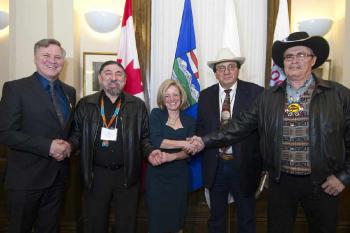Image Caption
By Shari Narine
Windspeaker Contributor
CALGARY
Three chiefs from the Blackfoot Confederacy made it clear they expect results from a relationship agreement signed with the province.
“Once we combine our resources, once we combine our political will, I think we can make a lot of change for the benefit of all our people, Blackfoot Confederacy, Albertans, and Canada as a whole,” said Siksika Nation Chief Joe Weasel Child.
Weasel Child was joined by Blood Tribe Chief Roy Fox and Piikani Nation Chief Stanley Grier on March 24 in signing the Alberta–Blackfoot Confederacy Protocol Agreement with Premier Rachel Notley in Calgary.
The agreement sets out a formal process for government and the confederacy to collaborate in several areas, including economic development, culture and language, social, political and legal issues, environment and lands, reconciliation, and the implementation of the United Nations Declaration on the Rights of Indigenous Peoples.
In fact, the chiefs already have economic development projects they plan to pursue on the strength of the new protocol agreement. Weasel Child noted a co-water management agreement between his Nation with the province for the Bassano Dam, as well as continuing talks that began when Ralph Klein was premier and centred on building a highway from the Coutts border crossing to Drumheller and possibly on to Fort McMurray.
Grier talked about creating jobs with the mining of metallurgical coal and the further development of renewable energy.
Fox stressed that he and the other chiefs would work closely with the province and “hopefully share in the profits of those ventures we get involved in together…. We are very willing to work with the Alberta government, very willing to share responsibilities on how we may make things better, not just for Albertans in general but for the people of …the Blackfoot Confederacy.”
Notley said the agreement established a “firmer basis for cooperation” and further demonstrated her government’s commitment to strengthening its relationships with Indigenous communities.
Initially, the agreement was to be between the government and the Treaty 7 Management Corporation, but with the dissolution of the corporation, talks continued between the province and the Piikani, Blood and Siksika Nations.
Grier said that as far as he knows, it is the first time the province had negotiated such an agreement outside of the Treaty areas. The agreement, which comes with a $375,000 grant to the First Nations for its implementation, will remain in place as long as both parties wish to keep it active.
It is the second agreement to be signed by the province and First Nations. Last spring, the province and Treaty 8 signed a protocol agreement.
“We are working very hard to keep our promises,” said Notley.
“This is a perfect storm of opportunity under this NDP government along with this federal Liberal government to work collectively in matters of mutual interest,” said Grier.
But he did not hesitate to add that court decisions are also strengthening First Nations.
“The modern Supreme Court of Canada decisions are really carving the way forward for us, enable us an opportunity to start looking at economic stimulus that will allow us not just to be independent, rather to be intradependent so we can start working collectively and mutually with the government of Alberta, with our local regions and other citizens throughout the province of Alberta,” said Grier.

